|
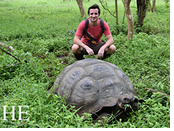 Existing in virtual isolation for millions of years, the Galapagos Islands are home to many species found nowhere else on Earth. Join this gay Galapagos cruise & wildlife tour and experience this abundance and variety of equatorial wildlife closely, as we walk, hike, snorkel, swim and imagine Darwin’s dream. Existing in virtual isolation for millions of years, the Galapagos Islands are home to many species found nowhere else on Earth. Join this gay Galapagos cruise & wildlife tour and experience this abundance and variety of equatorial wildlife closely, as we walk, hike, snorkel, swim and imagine Darwin’s dream.
Nowhere else in the world can you see and experience such an abundance and variety of wildlife as in the Galapagos Islands. A naturalist’s dream, the Galapagos Islands lie on the Equator, 600 miles west of Ecuador and the South American coastline. Formed as a result of intense volcanic activity, they consist of 61 islands and islets, with 13 main islands. Existing in virtual isolation for millions of years, they are home to many species found nowhere else on Earth. More than 1,900 of its more than 5,000 species are endemic.
Charles Darwin observed the potential scientific bonanza of the islands’ flora and fauna in 1835 and was inspired to write his famous thesis, "On the Origin of the Species by Means of Natural Selection". Aside from a few roving pirates and buccaneers, the islands remained untouched by man for centuries.
During the Galapagos tour, our naturalist guide will fill us in on the extraordinary variety of plants and wildlife as we will visit and explore various islands. A bird watcher’s paradise, there are 29 species of land bird found here and 22 of them are endemic to the islands. On this adventure, you will see the world’s smallest penguins, the bright red-chested frigate birds, the flightless cormorants, boobies, hawks, owls, and lava gulls.
In the sea, you’ll experience the wonder of watching giant sea turtles swimming to their homes, and sea lions playfully splashing as you snorkel along looking at multitudes of colorful fish. All this from the comfort of a modern and well-appointed ship.
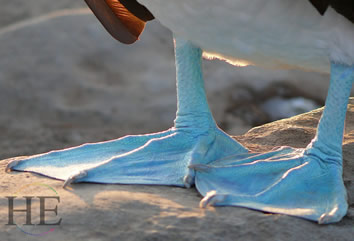
• Begin your journey with two nights in Ecuador’s mountain capital of Quito
• Relax on an upscale modern ship for four nights and enjoy the peace and quiet of these remote islands.
• See exotic birds and wildlife in their native setting.
• Visit the breeding grounds and sanctuary for giant green sea turtles.
• Swim with sealions and view an amazing bounty of fish and sea life.
• Hike along tidal lagoons, mangroves and bright, clean beaches.
• Experience Darwin’s inspiration in a lovely and pristine setting.
• Ask about availability of cabin types and also about land extensions around Quito and the mountains of Ecuador, such as to the exquisite new Mashpi Lodge.
• Sail on our deluxe ship among the islands
• Enjoy this once in a lifetime trek with a friendly group of gay men, lesbians, family and friends. (Please note that this is not a charter, so our gay group will be among other passengers on our comfortable ship.)
For a more active adventure, see our Gay Galapagos Land Tour
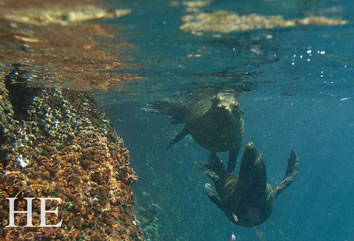
Days 1 - 2 -
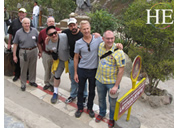 We arrive in Quito to begin our adventure. Since most flights arrive in the late evening, there are no official activities scheduled on arrival day. We arrive in Quito to begin our adventure. Since most flights arrive in the late evening, there are no official activities scheduled on arrival day.
After a good night’s sleep, we will spend today exploring Quito, Ecuador’s capital city, enjoying the Middle of the World and Intinan Museum along with the historic center plazas. We will have our Welcome Lunch today, while on our city tour. Enjoy a free evening tonight before we set off to the Islands in the morning.
Day 3 -
 After a morning flight from Quito via Guayaquil to Baltra Airport in the islands, we begin our exploration of the Northern Islands of the Galapagos. Our exact routing will depend on the Galapagos National Park Service, but the following is an example of the islands we may visit. Each day our naturalist-guides will lead us ashore on one island in the morning and another in the afternoon to view the variety of plant-life and marine and land animals, including flightless cormorants, blue-footed boobies, penguins, marine iguanas and giant tortoises. After a morning flight from Quito via Guayaquil to Baltra Airport in the islands, we begin our exploration of the Northern Islands of the Galapagos. Our exact routing will depend on the Galapagos National Park Service, but the following is an example of the islands we may visit. Each day our naturalist-guides will lead us ashore on one island in the morning and another in the afternoon to view the variety of plant-life and marine and land animals, including flightless cormorants, blue-footed boobies, penguins, marine iguanas and giant tortoises.
Arrival on Baltra Island
After our late morning landing at Baltra Island we will go to the pier to board our ship. Once on-board we will have an orientation to our cruise, the boat drill and lunch.
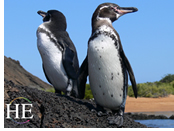 Las Bachas (Santa Cruz Island) Las Bachas (Santa Cruz Island)
After lunch we go to Las Bachas, on nearby Santa Cruz Island. This stretch of white sand beach that is broken up only by brackish lagoons that provide rich feeding areas flamingos, stilts and other wading birds. While ashore we will follow coastal and inland paths to see bird colonies, marine iguanas and sea lions. Once back on the ship we will meet up for our welcome cocktail, hear about our plan for the next day’s touring, and have our first dinner onboard our ship.
Day 4 -
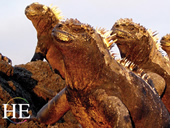 This morning we will sail to the tiny Bartholomew (Bartolomé) Island. We will embark on our dinghies (inflatable boats for going ashore on islands with no pier) for an optional 375-foot climb on a wooden staircase to the summit, to enjoy a panoramic view of the landmark Pinnacle Rock. A tiny colony of Galapagos penguins resides at the foot of the rock. Ride the dinghy around this colossal-sized rock and enjoy the wildlife. This morning we will sail to the tiny Bartholomew (Bartolomé) Island. We will embark on our dinghies (inflatable boats for going ashore on islands with no pier) for an optional 375-foot climb on a wooden staircase to the summit, to enjoy a panoramic view of the landmark Pinnacle Rock. A tiny colony of Galapagos penguins resides at the foot of the rock. Ride the dinghy around this colossal-sized rock and enjoy the wildlife.
After lunch, we will head to Sullivan Bay on the east coast of Santiago. Located here is a white coral sand beach that is ideal for enjoying some time swimming and snorkeling, perhaps with penguins. As we set sail, look for the dolphins that live in this area, and which sometimes enjoy swimming alongside the boats.
Day 5 -
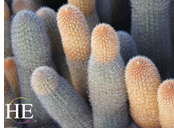 This morning we will enjoy a walk and enjoy the fascinating landscapes of Dragon Hill. We will head past a brackish-water lagoon, frequented by ducks, American Flamingos, and shorebirds. As we make our way inland, the trail offers a beautiful view of the bay and western islands of the archipelago. Afterward, enjoy some snorkeling from the shore. This morning we will enjoy a walk and enjoy the fascinating landscapes of Dragon Hill. We will head past a brackish-water lagoon, frequented by ducks, American Flamingos, and shorebirds. As we make our way inland, the trail offers a beautiful view of the bay and western islands of the archipelago. Afterward, enjoy some snorkeling from the shore.
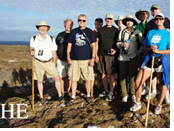 Next up is James Bay, as we follow in the footsteps of Charles Darwin. He spent about 6 days exploring this island in 1835. Mockingbirds, lava lizards, yellow warblers doves, hawks, and finches are just a handful of the species he encountered. We will head uphill for an amazing panoramic view. The salt from this lagoon was mined in the 20th century, but luckily the business didn’t take off. Next up is James Bay, as we follow in the footsteps of Charles Darwin. He spent about 6 days exploring this island in 1835. Mockingbirds, lava lizards, yellow warblers doves, hawks, and finches are just a handful of the species he encountered. We will head uphill for an amazing panoramic view. The salt from this lagoon was mined in the 20th century, but luckily the business didn’t take off.
Day 6 -
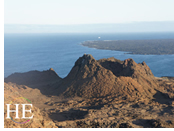 We head to shore by dinghy today, to seek out colonies of Galapagos fur seals, Nazca boobies, penguins, and much more. Depending on the conditions of the ocean, we’ll be able to snorkel along the cliffs, hopefully in the company of green sea turtles. Back on board, we navigate along the Bolivar Channel, where nutrient-rich upwellings provide fertile fishing grounds for cetaceans. We head to shore by dinghy today, to seek out colonies of Galapagos fur seals, Nazca boobies, penguins, and much more. Depending on the conditions of the ocean, we’ll be able to snorkel along the cliffs, hopefully in the company of green sea turtles. Back on board, we navigate along the Bolivar Channel, where nutrient-rich upwellings provide fertile fishing grounds for cetaceans.
We will end our journey on a high note by visiting the island of Fernandina, the youngest island of the archipelago, and arguably one of the most pristine ecosystems on the planet. Punta Espinoza boasts a fantastic combination of apparently barren landscapes and abundant wildlife, all dominated by the lofty volcano at the heart of the island. Highlights to spot include hawks, penguins, vast numbers of marine iguanas, and the famous flightless cormorant, with its beguiling blue eyes.
Day 7 -
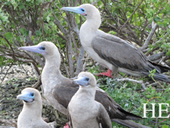 Today we make our way back to Baltra Island to the airport, for our flight back to Quito, with a stop in Guayaquil. Today we make our way back to Baltra Island to the airport, for our flight back to Quito, with a stop in Guayaquil.
We will arrive in Quito in the late afternoon. We will reserve a hotel room in Quito tonight for anyone joining the Mashpi Extension or flying home the next day. However, if your flight home departs around midnight, you can stay at the airport or get a "day room" at a nearby hotel, and depart tonight.

After your immersion in the carefully preserved natural environment of the Galapagos, please consider joining our extension to the incredible new Mashpi Lodge in the cloud forest in the Andes highlands outside Quito. This lodge opened in 2012 and quickly won awards for its unique architecture and commitment to blend as seamlessly as possible into the natural environment of the Mashpi Biodiversity Reserve.
Day 7 -
Our Galapagos tour ends after we return to Quito on the last evening. For those staying on, we’ll spend tonight in Quito and begin our journey to the Andean Highlands the next day.
Day 8 -
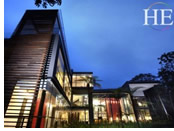 A stay at Mashpi Lodge starts with a morning drive from Quito to the Lodge. Along with way make a stop at the recently-opened Tulipe archaeological site. This was the ceremonial grounds for the Yumbo people who lived in the region between about 800 AD and 1660 AD. They were known for their keen observation of the heavens from their high-mountain location right on the equator. Being near a major pass of the Andes, they also prospered as merchants on the trade routes between the Pacific coast indigenous communities, and those of the Amazon basin. A stay at Mashpi Lodge starts with a morning drive from Quito to the Lodge. Along with way make a stop at the recently-opened Tulipe archaeological site. This was the ceremonial grounds for the Yumbo people who lived in the region between about 800 AD and 1660 AD. They were known for their keen observation of the heavens from their high-mountain location right on the equator. Being near a major pass of the Andes, they also prospered as merchants on the trade routes between the Pacific coast indigenous communities, and those of the Amazon basin.
This 2.5-hour drive takes you to the edge of the Reserve, where you stop at the Hummingbird Viewpoint and change to an electric cart for the final 4 miles to the Lodge. (To give an idea of the variety of birds here, 22 species of hummingbirds alone have been found in the reserve, along with such fascinating species like the Andean Cock-of-the-Rock and Club-Winged Manakin). In the afternoon, the Naturalist Guides will give you an overview of the Reserve and your activity options. All meals at the Lodge are included in the extension price, including night walks after dinner, accompanied by one of the Naturalist Guides.
Day 9 -
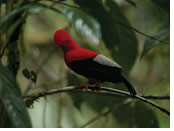 The day’s activities start with a guided hike before breakfast, when you can be out with the myriad species of birds and other animals as the actively (and noisily!) start their day. You will see why this region is considered one of the richest birding habitats in the world. The day’s activities start with a guided hike before breakfast, when you can be out with the myriad species of birds and other animals as the actively (and noisily!) start their day. You will see why this region is considered one of the richest birding habitats in the world.
The Naturalist Guides offer a variety of activities throughout the day including hikes through the dense jungle or a chance to cool off under a cascading waterfall. Rubber boots, rain ponchos and binoculars are provided during your stay. There is even an aerial bicycle to let you glide through the jungle, leaving literally no footprint.
On the outbound journey there will be a mile-long gondola ride that allows hikes deeper in the rainforest, far from any roads. The 6-passenger gondolas ride high above the trees, allowing an overview of the vast forest canopy, and on the return journey the cables are much lower, so that visitors can get a more intimate view of the rich profusion of plants and animals that thrive below the tree canopy.
When you return to the Lodge, you can relax on the terrace, or in your room, each of which features north-facing floor-to-ceiling windows. One window can be opened, so if you wish you can wake up to the profusion of birds calling to each other at dawn.
Day 10 -
 Take one more nature hike this morning, then in late morning, start your return drive to Quito. Take one more nature hike this morning, then in late morning, start your return drive to Quito.
Along with way make a stop at the recently-opened Tulipe archaeological site. This was the ceremonial grounds for the Yumbo people who lived in the region between about 800 AD and 1660 AD. They were known for their keen observation of the heavens from their high-mountain location right on the equator. Being near a major pass of the Andes, they also prospered as merchants on the trade routes between the Pacific coast indigenous communities, and those of the Amazon basin.
We’ll be back in Quito in late afternoon.
Our tour extension ends with a drop-off at Quito Airport in time for evening flights. An optional overnight stay near Quito Airport can be added if you are taking a flight the next day.
OR Stay Longer and Visit Machu Picchu in Peru!
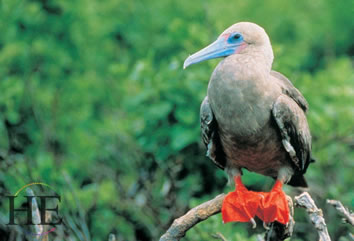
|